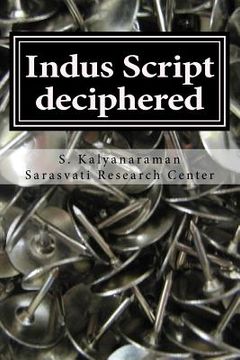Compartir
Indus Script Deciphered: Rosetta Stones, Mlecchita Vilalpa, 'meluhha Cipher' (en Inglés)
S. Kalyanaraman
(Autor)
·
Sarasvati Research Center
· Tapa Blanda
Indus Script Deciphered: Rosetta Stones, Mlecchita Vilalpa, 'meluhha Cipher' (en Inglés) - Kalyanaraman, S.
$ 26.630
$ 36.980
Ahorras: $ 10.350
Elige la lista en la que quieres agregar tu producto o crea una nueva lista
✓ Producto agregado correctamente a la lista de deseos.
Ir a Mis Listas
Origen: Estados Unidos
(Costos de importación incluídos en el precio)
Se enviará desde nuestra bodega entre el
Lunes 24 de Junio y el
Viernes 28 de Junio.
Lo recibirás en cualquier lugar de Chile entre 1 y 3 días hábiles luego del envío.
Reseña del libro "Indus Script Deciphered: Rosetta Stones, Mlecchita Vilalpa, 'meluhha Cipher' (en Inglés)"
A brief overview on 6 rosetta stones & the method of Indus Script decipherment. The cipher is rebus-metonymy layered Meluhha (mleccha speech). Signs and pictorials are hieroglyph multiplexes of Indian sprachbund of Bronze Age Ancient Near East. The language of the writing system is Prakritam. Indus Script Corpora surveyed as catalogus catalogorum of metalwork include c. 7000 inscriptions along the Maritime Tin Road from Hanoi, Vietnam to Haifa, Israel. Meluhha people who created the Sheffield of Ancient Near East in Chanhu-daro, invented and used writing in the River Valleys of Sarasvati, Indus(Sindhu) rivers and Indo-Iran borderlands.An ancient document Rigveda refers to these people as Bharatam Janam who lived on the banks of Rivers Sarasvati and Sindhu. They mediated the maritime trade of tin from the Tin Belt of the world in Ancient Far East. Meluhha settlements are attested in cuneiform texts. A cylinder seal of Shu-ilishu points to an Akkadian translator needed to transact with the Meluhhan seafaring merchant. The discovery of two pure tin ingots in a shipwreck in Haifa points to the links with the Nahal Mishmar cire perdue artifacts. The continuum of the writing system is evident on hundreds of hieroglyphs of the Indus Script which continue to signify metalwork on early punch-marked coins with Kharoshti and Brahmi syllabic scripts used conjointly. Inscriptions signify metalwork catalogues on copper plates. Such inscriptions point to the possibility of printing such copper plates on tree-barks or other media for dissemination of artisans' messages. The unique hypertext formats of Indus Script Corpora provide a framework for improved cyber security and advanced encryption systems with multi-layered hieroglyph multiplexes. Successful decipherment points to the need for re-evaluating the formation and evolution of Ancient Indian languages. Austro-asiatic, Indo-Aryan and Dravidian speakers seem to have formed an Indian sprachbund (speech union) during the early Bronze Age as evidenced by the many metalwork glosses present in all these language streams. The presence of Sivalinga in Harappa and of over 80% of the archaeological settlements on the banks of Vedic River Sarasvati, the tradition of wearing sindhur (vermilion) at the parting of the hair by married women, wearing turbinella pyrum (sankha) bangles, persons seated in penance yoga postures attest to the continuum of Sarasvati-Sindhu Civilization into the historical periods of ancient India. What Geoerge Coedes calls in his work Histoire ancienne des états hindouises d'Extrême Orient,1944 is an attestation of the dharma-dhamma as the founding principles of state formation in India and in the Far East. Further researchers into the Maritime Tin Road from Hanoi, Vietnam exemplified by Dong Son Bronze Drums and the 3rd millennium BCE Bronze Age site of Bon Chiang will be significant contributions to archaeometallurgical studies to further evaluate the nature of the tin-bronze revolution achieved from 3rd millennium BCE. The contours of the Indian sprachbund (speech union) have to be further outlined by comparative and historical studies in Indo-European linguistics and Chandas of Vedic times in relation to mleccha (meluhha) speech or vaak. The presence of ancu of Tocharian as a cognate of ams'u (synonym of Soma) in Rigveda points to the oral transmissions of knowledge systems and Vedic heritage across Eurasia. The narrative of Soma has not yet been fully told; it is clear that Soma is in nuce in the ancient human document, the Rigveda. A tree associated with smelter and linga from Bhuteshwar, Mathura Museum. Architectural fragment with relief showing winged dwarfs (or gaNa) worshipping with flower garlands, Siva Linga. Bhuteshwar, ca. 2nd cent BCE.
- 0% (0)
- 0% (0)
- 0% (0)
- 0% (0)
- 0% (0)
Todos los libros de nuestro catálogo son Originales.
El libro está escrito en Inglés.
La encuadernación de esta edición es Tapa Blanda.
✓ Producto agregado correctamente al carro, Ir a Pagar.

